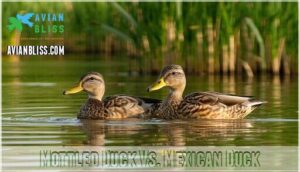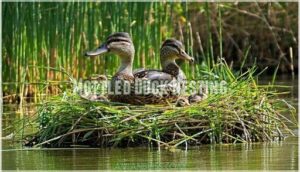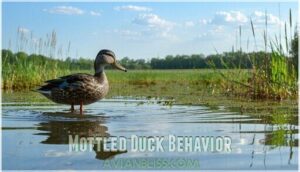This site is supported by our readers. We may earn a commission, at no cost to you, if you purchase through links.

This medium-sized dabbling duck calls the Gulf Coast home, from Florida to Texas, preferring coastal marshes and shallow wetlands year-round.
Unlike migrating waterfowl, mottled ducks stick to their territories, making them reliable residents of brackish and freshwater habitats.
They’re surface feeders, dabbling for aquatic vegetation and invertebrates in shallow waters, and are similar to mallards, but their darker, more uniform coloring and specialized coastal lifestyle set them apart.
Conservation concerns are mounting as Louisiana populations have plummeted 65% since 2009, despite their current "Low Concern" status, and what makes these ducks so uniquely adapted to coastal life might surprise you.
Table Of Contents
- Key Takeaways
- Mottled Duck Vs. Black Duck
- Mottled Duck Vs. Mexican Duck
- Mottled Duck Nesting
- Mottled Duck Behavior
- Mottled Duck Conservation
- Mottled Duck Identification & Description
- Mottled Duck Distribution Range
- Frequently Asked Questions (FAQs)
- What is the difference between a mottled duck and a black duck?
- What is the difference between a mottled duck and a Mexican duck?
- Do mottled ducks lay eggs?
- Is a mottled duck a gadwall?
- What is the average lifespan of a mottled duck?
- How do mottled ducks form pair bonds?
- What is the primary threat to the conservation of mottled ducks?
- How does climate change impact the range of mottled ducks?
- What do mottled ducks eat daily?
- How long do mottled ducks live?
- Conclusion
Key Takeaways
- You’ll identify mottled ducks by their distinctive mottled brown plumage and bright yellow bills with black spots – unlike mallards or black ducks, they display darker, more uniform coloring that makes them stand out in coastal marshes.
- You won’t see these ducks migrating since they’re year-round Gulf Coast residents – from Florida to Texas, they stick to their brackish and freshwater territories, making only local movements when water levels change.
- You’ll find their conservation status concerning despite being labeled "Low Concern" – Louisiana populations have dropped 65% since 2009 due to habitat loss, coastal development, and hybridization with mallards threatening their genetic integrity.
- You can spot their nests hidden in dense vegetation within 100 yards of water – females construct shallow ground depressions lined with grass and down feathers, laying 8-12 eggs with a 24-28 day incubation period handled exclusively by the female.
Mottled Duck Vs. Black Duck
When comparing mottled duck vs black duck, you’ll notice key differences in duck species identification.
Mottled ducks display lighter buff and brown feather patterns, while black ducks show darker, uniform plumage throughout.
Bill color provides another essential identifier—male mottled ducks sport bright yellow bills with diagnostic black spots at the gape, whereas black ducks lack this distinctive marking.
The speculum difference is equally telling: mottled ducks feature bluish-green wing patches often without white borders, while black ducks display purple speculums.
Size variation between these waterfowl species remains minimal, making plumage and bill characteristics your best bet for accurate bird identification in the field.
Understanding duck identification techniques is essential for hunters and bird enthusiasts to distinguish between similar species.
Mottled Duck Vs. Mexican Duck
While the American Black Duck shares similar coloration with the Mottled Duck, you’ll find even closer kinship when examining duck species like the Mexican Duck.
These two represent fascinating species distinction challenges that test even experienced birders.
Duck comparison reveals subtle but important plumage differences. You’ll notice the Mexican Duck displays a duskier face with fine black feathering, while the Mottled Duck shows a cleaner, paler buffy appearance.
Bill coloration provides another key identifier – Mottled Ducks sport bright yellow bills with diagnostic black gape spots, whereas Mexican Ducks show duller olive-yellow coloring without the distinctive spot.
| Feature | Mottled Duck | Mexican Duck |
|---|---|---|
| Face Color | Clean, pale buff | Dusky with black feathering |
| Bill Color | Bright yellow with black gape spot | Dull olive-yellow, no gape spot |
| Speculum Edge | No white edging | White-edged speculum |
Understanding Mexican Duck taxonomy is essential for effective conservation efforts.
Hybridization risks concern waterfowl management professionals, particularly in south Texas where ranges overlap. This hybridization creates identification challenges, making field distinction increasingly complex for wildlife biologists and birders alike.
Mottled Duck Nesting
You’ll find mottled duck nests hidden in dense vegetation near water sources, where females carefully construct shallow ground depressions lined with grass and their own down feathers.
Mottled ducks craft their hidden nurseries with the precision of master architects, weaving grass and down into perfect cradles
These secretive nesters typically choose locations within tall marsh grasses or under shrubs, providing essential cover during the vulnerable 24-28 day incubation period, which is a critical time for the nests’ survival.
Nest Placement
You’ll find mottled ducks selecting nest sites in dense vegetation within 40 square miles of water sources.
During breeding season, these waterfowl demonstrate specific nesting habits that guarantee successful duck breeding. Their habitat requirements drive strategic placement decisions for maximum brood rearing success.
Effective duck nesting requires proper installation of Duck Nesting Boxes.
Key Nest Sites:
- Dense grass clusters – Thick vegetation provides concealment from predators during egg laying periods
- Shrub understory – Low-growing bushes offer protective cover while maintaining water access
- Marsh edges – Elevated areas near wetlands balance safety with proximity to feeding grounds
Nest Description
The architecture of a mottled duck’s nest reveals remarkable precision in duck breeding design. These carefully crafted structures showcase distinctive nesting habits that guarantee successful reproduction throughout the breeding season.
Here’s what you’ll find in a typical mottled duck nest:
- Nest Materials: Females weave together grasses, sedges, and cattail stems, then line the interior with soft down feathers plucked from their own breast during incubation.
- Nest Size: The bowl-shaped structure measures roughly 8-10 inches across and 3-4 inches deep, perfectly sized to cradle 8-12 cream-colored eggs.
- Brood Habitat: Located in dense vegetation within 100 yards of water, these nests sit on dry ground slightly elevated above potential flood levels.
The Incubation Period lasts 24-28 days, with females rarely leaving their Egg Color treasures unattended. Mottled ducks often utilize effective duck nesting boxes to raise their young safely.
Nesting Facts
When you understand mottled duck nest placement, their nesting habits become clearer.
These waterfowl demonstrate remarkable breeding season patterns, with females laying 8-12 eggs during their single annual brood. The incubation period spans 24-28 days, handled exclusively by females.
Ducklings leave the nest within 24-48 hours, beginning their brood rearing journey. Fledging time occurs around 60-70 days when young achieve flight capability.
Nesting success varies substantially by habitat quality and predator pressure. Proper duck nesting boxes can greatly improve nesting success rates.
Fact Detail
Mottled Duck Behavior
Once nesting concludes, mottled ducks display fascinating behavioral patterns that reveal their remarkable adaptability. These dabbling ducks exhibit sophisticated Feeding Strategies, primarily surface-feeding by tipping forward to reach submerged vegetation and invertebrates.
Diet Analysis shows adults consume over 99% plant material, while ducklings initially focus on protein-rich invertebrates.
Foraging Habits include:
- Dabbling behavior – tipping tail-up to access underwater food sources
- Surface gleaning – collecting seeds and insects from water’s surface
- Marsh browsing – grazing on emergent vegetation in shallow areas
Social Interactions occur in pairs or small flocks, with breeding pairs forming during fall courtship. Unlike many waterfowl, Migration Patterns show minimal movement – they’re basically homebodies, making only local shifts between seasonal habitats when water levels fluctuate.
Mottled Duck Conservation
Anyone concerned about duck populations should know mottled ducks face serious challenges despite their "Low Concern" status.
Conservation efforts focusing on habitat restoration and wetland conservation are essential as Louisiana populations dropped 65% since 2009.
Habitat preservation battles coastal marsh loss, declining rice agriculture, and urban development.
Lead exposure and predation compound survival issues, while species protection addresses genetic introgression with mallards threatening population integrity.
Environmental impact from climate change affects their brackish marsh habitats.
Current mottled duck conservation prioritizes private land restoration and spring wetland establishment for bird conservation status improvement.
Mottled Duck Identification & Description
Identifying a Mottled Duck requires attention to several distinctive features that set this species apart from similar waterfowl.
These medium-sized dabbling ducks display unique characteristics that make duck identification manageable once you know what to look for.
Key identification features include:
- Bill Colors – Males sport bright yellow bills with distinctive black spots at the gape, while females show orange bills with variable black spotting
- Plumage Patterns – Rich brown mottled feathers with buff-colored edges create the signature "mottled" appearance across the body
- Duck Size – Medium build measuring 1.8-2.7 pounds for males and 1.5-2.5 pounds for females, with wing lengths averaging 10.2 inches
- Speculum Features – Blue-green iridescent wing patches lack the white borders typical of mallards
The Feather Texture appears uniformly mottled without pronounced sexual dimorphism seen in related species.
Both sexes share similar plumage coloration, making this bird description somewhat unique among dabbling ducks.
Their buff-colored heads and throats contrast beautifully with darker body feathers.
Mottled Duck Distribution Range
You’ll find Mottled Ducks primarily along the Gulf of Mexico coast from Alabama to northeastern Mexico, plus throughout peninsular Florida.
These non-migratory birds stick to their geographic range year-round, inhabiting freshwater wetlands, coastal marsh ecosystems, and brackish waters.
The Southeastern United States supports their largest populations, though habitat loss threatens their distribution range.
Texas and Louisiana hold the highest concentrations, while Florida’s population faces challenges from development.
Unlike migrating waterfowl, Mottled Ducks remain faithful to their wetland habitats, making local movements only when conditions change.
Frequently Asked Questions (FAQs)
What is the difference between a mottled duck and a black duck?
Over 40% of mottled duck habitat has vanished since
You’ll spot key differences: mottled ducks have dark brown bodies with buff heads and yellow bills, while black ducks appear darker overall with orange bills and purple wing patches.
What is the difference between a mottled duck and a Mexican duck?
You’ll spot key differences when comparing these Gulf Coast ducks.
Mexican ducks display a distinctive white collar around their necks, which mottled ducks completely lack.
Additionally, Mexican ducks have lighter, more buff-colored bodies and bold white borders on their wing patches, contrasting with mottled ducks’ darker brown plumage.
Do mottled ducks lay eggs?
Surprisingly, these seemingly simple waterfowl don’t just appear magically—they’re egg-laying champions.
You’ll find mottled ducks producing clutches of 5-13 eggs annually during their March breeding season.
They incubate them for 24-28 days in ground nests.
Is a mottled duck a gadwall?
No, you’re looking at two completely different duck species. Gadwalls and mottled ducks belong to distinct taxonomic groups with different physical characteristics, behaviors, and habitats despite both being dabbling ducks.
What is the average lifespan of a mottled duck?
Wild waterfowl typically live 5-7 years, but you’ll find mottled ducks averaging just 5 years in their natural habitat.
These resilient birds can reach 13+ years when conditions align perfectly, though captivity extends lifespans to 20 years maximum.
How do mottled ducks form pair bonds?
You’ll notice pair bonds form early in winter when courtship begins, extending through November.
Males and females engage in specific movements and vocalizations during this bonding process, establishing monogamous partnerships that last annually, and this process is crucial for the formation of pair bonds.
What is the primary threat to the conservation of mottled ducks?
Habitat destruction and mallard hybridization create a perfect storm you’ll find devastating these Gulf Coast natives.
Crossbreeding with feral mallards threatens genetic integrity while coastal development destroys essential wetland homes throughout their range.
How does climate change impact the range of mottled ducks?
Climate change affects you’ll observe range shifts as rising temperatures and altered precipitation patterns modify coastal marsh habitats.
Potentially forcing populations northward while simultaneously threatening critical Gulf Coast breeding grounds through increased storm intensity and sea-level rise, is a consequence of these modifications to habitats.
This situation is further complicated by sea-level rise.
What do mottled ducks eat daily?
Like a feathered vacuum cleaner, you’ll find these ducks consuming aquatic plants, seeds, invertebrates like snails and beetles, small fish, and crustaceans through surface dabbling in shallow waters.
How long do mottled ducks live?
You’ll find mottled ducks live about 5 years in wild conditions, though captivity can extend their lifespan up to 20 years. The oldest recorded individual reached 13 years and 7 months.
Conclusion
Ironically, these supposedly sedentary coastal residents face greater mobility threats than their migratory cousins.
You’ve now discovered how the mottled duck’s specialized adaptations to Gulf Coast marshlands make them both uniquely successful and surprisingly vulnerable.
Their year-round residency, distinctive mottled plumage, and surface-feeding behavior distinguish them from similar species, yet habitat loss continues threatening their populations.
Understanding their nesting requirements and conservation needs helps you appreciate why protecting coastal wetlands remains critical for maintaining healthy mottled duck populations throughout their limited range.







